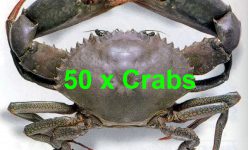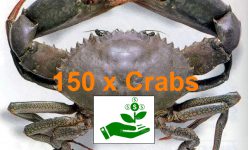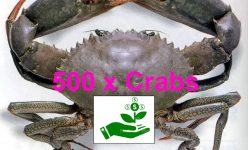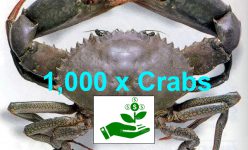Rewards

Available Soon

Available Soon

Available Soon

Available Soon
Your Support
We need your support to raise $150,000 for a POC, that will lead a clear path to the success of a commerical scale indoor Mud Crab Breeding/Farming System, which will provide relief to the Australian wild crab stocks, generate a ready available supply of A-Grade mud crabs all year round, create an Australian grown export resource that will create jobs and benefit the Australian economy.

For supporters that see commercial potential of indoor Mud Crab Farming, along with it’s export opportunity; we are offering various Reward Packages that guarantee each supporter the option to obtain equity in the commercial scale Mud Crab Farming business, through the Series “A” investment offering, which will be released in July 2022 when the POC has been proven.
The commercial scale farm will occupy an already sourced industrial premise of 1436sqm in Bundaberg Qld, able to produce 96,000 Mud Crabs from 600 x Vertical Farm Systems, and generate a total income revenue stream of more than $4.7mil p.a from exports to China, Taiwan, and Japan.
Construction of the commercial scale farm is scheduled to start in September 2022, and be completed by December 2022; setting the stage for this new aquaculture farm to produce its first monthly batch of 8,000 crabs by July 2023.
Expansion of the business will start in July 2024, with plans to tripple production by excercising an already in place “Buy Option” to acquire a 50 acre estuary front property in Bundaberg. This expansion will see the export capacity reach more than 288,000 crabs by July 2026, and a further expansion which will produce a total of 576,000 crabs by 2030.
Seed Funding – $150,000 for POC
The “Proof of Concept” will be to prove two main functions of indoor mud crab farming –
a) Successfully breed crablets from wild caught brood stock
b) Successfully raise crablets to harvest size (0.75kg to 1kg) within 6 to 7 months
With over 35 years experience in various companies focused around manufacturing, electronic hardware development, custom software solutions, and with personal interests/experience in marine aquariums; we have designed a unique indoor vertical farming system, that maximises high production per square metre of floor space, capable of farming 66 x Mud Crabs per SQM p.a.
Funding will be used to setup a indoor breeding facility in Bundaberg, where wild caught Brood Stock will be housed and breeding conditions established.

The Seed Funding will also be used to take our unique vertical farm system from design to working concept, where the trial system will setout to prove successful farming of crablets to grow-out harvest size of 750g to 1000g within a period of 6 to 7 months. The size of the trial farming system will have a capacity to produce 858 x crabs per harvest, or 1716 pa.
The trial of our unique vertical farm system design, is to test the technology that will be used in up scaling our farming system that will occupy a industrial building size of 1436sqm, with the ability to produce 96,000 crabs each year.
POC Timeline – 12 Months
From the time we receive the required Seed Funding, we expect to have successfully bred crablets within the first 4 months, and the following 6 to 7 months to grow out the first harvest of 858 x crabs.
POC Scheduled Process
1. Manufacture crab housing and breeding facility
2. Collect wild brood stock of Mud Crab species “Scylla serrata”
3. Start breeding process
During the crab breeding period, manufacture the vertical farming system.
4. Successful hatch of crablets
5. Move crablets to individual holding pens for grow-out stage
6. Crab grow-out stage
7. Harvest crabs
8. Proof of Concept proven, invite investors to Series “A” investment opportunity for large scale vertical farming system, capable of producing 8,000 crabs per month. Required investment AUD$3mil with a total equity grab of 37.5%.
Breeding Crablets
As a boy growing up, I was introduced to saltwater aquariums and marine life through my grandfathers interests in keeping and collecting various species of fish and corals. In one section of my grandfathers shed, he also kept a couple of tanks of mud crabs, where he learnt through trial and error, the breeding of crablets.

I have strong memories around his crablet breeding success; when the crablets reached a size of around 15mm, we would release them in various saltwater estuary locations close to my home; which provided the estuary system with fun crabbing adventures and eating freshly cooked chillie crab on a regular basis.
My grandfather past away in 1996 and took with him his crablet breeding experience, which I thought until of recent (Aug 2020); when it was time to move my parents into age care and sell the family home of more than 50 years, I came across a box that contained my grandfathers notes and experience of breeding crablets.
Since finding my grandfathers notes, I have invested time in researching a commercial scale mud crab farm, using both a) my grandfathers experience in breeding crablets, and, b) adopting vertical farming practices but with a twist of AI technology and improved system design.
Vertical Farming System – Design
Vertical mud crab farming has been in practice for many years now, first adopted in Asia, and now becoming a vastly accepted farming process, which solves the main issue of Cannibalistic interactions between crabs in traditional farming ponds.

Current vertical farming systems used in Asia, have many design faults and issues, inparticular the need for floor space which determines production, and the intense labour required to maintain the system so that healthy A-Grade crabs are produced.
Our unique vertical farming system design, addresses issues that will enable us to farm healthy A-Grade crabs, minimise labour costs, reduce electricity expenses, and increase harvest production per sqm of floor space.
To date, vertical mud crab farming has not been adopted in Australia; the supply of commercial mud crab quantities are sourced from the wild by licenced operators, which questions the sustainability of the global growing demand for mud crab.
The Global Crab Market will reach 3.7 Million Metric Tonnes by the end of 2026.
Due to global rising consumer demand, the future of crab industry is bright. The food service industry is the major end-user of crabs; the rise of the food service industry would directly surge the inclination of the global crab market.

Australian Live Crab Export Performance (Stats by FRDC)
2020 to date – 110,061kg @ average AUD$49.84 per kg

2019/2020 – 148,567kg @ average AUD$43.99 per kg

2018/2019 – 138,076kg @ average AUD$35.12 per kg

2017/2018 – 123,530kg @ average AUD$34.87 per kg

2016/2017 – 61,330kg @ average AUD$36.25 per kg

Market Trends & Drivers
* Growing Preference for Healthy, Nutritious, and Protein-Rich Diets Drive Healthy Demand for Seafood.
* Surging Demand for Fresh/Live/Chilled Seafood Catapults the Category to the Dominant Position.
* Seafood Retailing Gains Momentum through Online and E-Commerce Platforms.
* Crustaceans: Low-Volume, High-Revenue Generating Segment.
* The Vital Need to Meet Food Security Concerns of the Expanding Global Population Opens Up Growth Avenues.
* Increasing Per Capita Seafood Consumption to Benefit Market Expansion.
* Retail Sector Growth Contributes to Sales Volume Expansion.
Aquaculture Investment – A sure thing!
A flood of new funds are investing in aquaculture, fisheries and seafood. Will they succeed?
New aquaculture investment fund betting industry’s sustainable growth will yield big returns!
New group is looking to connect institutional capital focused on weighty issues such as food security with aquaculture ventures designed to address such issues.
Aquaculture as an industry has been historically under capitalized, under-banked and less well understood by traditional institutional investors,’ said Todd Crescenzo, co-founder of Varuna.
‘From hunters to farmers of fish’: French venture capital firm on the lookout for innovative aquaculture tech.
Blue Oceans Partners has its sights set on innovations that bolster sustainable aquaculture and end overfishing, the managing partner told IntraFish.
Agrifood investors head to the beach – but not for vacation.
Two $100-million fund announcements and a spate of deals in August signal growth in sustainable seafood and aquaculture investment opportunities.
Australian exporters are generally very well-positioned to respond to any emerging demand for environmentally-sustainable seafood in China.
As the global population rises to 9 billion people in 2050 and economic development expands, the demand for seafood is expected to increase by 70%.
Aquaculture a new investment frontier. Aquaculture has become one of the world’s fastest-growing industries, including in Australia and New Zealand.
Northern Australia Aquaculture could quintuple production in five years. The aquaculture industry in northern Australia has the potential to increase its production fivefold to more than AUD$1.34 billion in value over the next five years, new research has found.

Former Mowi and BioMar bosses behind new seafood investment company.
How this impact Investor is generating double-digit returns, cleaning up the Seafood Business.
According to Taiwanese customs data, imports of seafood from Australia, New Zealand and the US have doubled since 2012, from $36.1 billion to $73.7 billion in 2019.
No Comments yet. Be the first one to comment!
Please log in or register to post comments